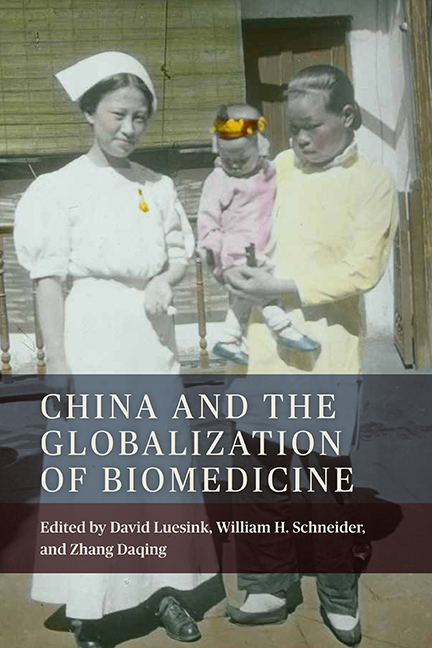Book contents
- Frontmatter
- Dedication
- Contents
- List of Illustrations
- Preface
- Acknowledgments
- List of Abbreviations
- Introduction: China and the Globalization of Biomedicine
- Part One Hygiene and Disease Construction in Late Qing China
- Part Two The Indigenization of Biomedicine in Republican China
- Part Three The Spread of Biomedicine to Southwest China, 1937–1945
- Afterword: Western Medicine and Global Health
- List of Chinese and Japanese Terms and Names
- Selected Bibliography
- List of Contributors
- Index
7 - Frontiers of Immunology: Medical Migrations to Yunnan, Vaccine Research, and Public Health during the War with Japan, 1937–1945
Published online by Cambridge University Press: 27 March 2021
- Frontmatter
- Dedication
- Contents
- List of Illustrations
- Preface
- Acknowledgments
- List of Abbreviations
- Introduction: China and the Globalization of Biomedicine
- Part One Hygiene and Disease Construction in Late Qing China
- Part Two The Indigenization of Biomedicine in Republican China
- Part Three The Spread of Biomedicine to Southwest China, 1937–1945
- Afterword: Western Medicine and Global Health
- List of Chinese and Japanese Terms and Names
- Selected Bibliography
- List of Contributors
- Index
Summary
In September 1938, a man named Tang Feifan drove into the southwestern Chinese city of Kunming. He was at the head of a convoy of six trucks that carried rabbits, glass bottleware, and a variety of scientific instruments. Tang's curious cargo was a consequence of his position as the new chief of the National Epidemic Prevention Bureau (NEPB), a Chinese government agency that developed, manufactured, and distributed vaccines. Originally stationed in Beijing and Nanjing, Tang and his staff had been forced to flee these cities as the Japanese army expanded its occupation of China during World War II. When China's Nationalist government fled to Chongqing in 1937 and established its wartime base of operations there, a variety of official bureaus, private companies, and institutions of higher learning also moved their personnel and offices to China's far southwest. Tang and his staff had joined this exodus. The NEPB set up temporary facilities in Changsha in 1937 but moved again the next year to Kunming, capital of Yunnan Province. Here, Tang faced the formidable challenge of reestablishing an institute that could provide wartime China with vaccines and sera while withstanding bombings, supply shortages, and epidemic outbreaks.
The road to Kunming was not lonely. Between 1937 and 1945, Kunming became a temporary home to a large population of biomedical experts, both Chinese and foreign. Yunnan's capital had quickly become a center of education and intellectual inquiry in the wartime Republic. In 1938, faculty and students at three of China's most prominent universities—Peking, Tsinghua, and Nankai—had established the Southwest National United University, or Lianda, in Kunming. Their precedent attracted other refugee institutions of higher education, and as a result, a number of prominent medical schools like the National Tongji University Medical College and the National Shanghai Medical College moved their wartime instruction to Yunnan. Biomedical experts streamed into Kunming from the west as well, joining the community of medical research and education that these schools and governmental institutes, like the National Epidemic Prevention Bureau, were building. As the eastern terminus of the wartime Burma Road, a strategic supply route crossing the Allied China-Burma-India military theater, Yunnan's capital also became a base of operations for international aid organizations.
- Type
- Chapter
- Information
- China and the Globalization of Biomedicine , pp. 183 - 214Publisher: Boydell & BrewerPrint publication year: 2019

